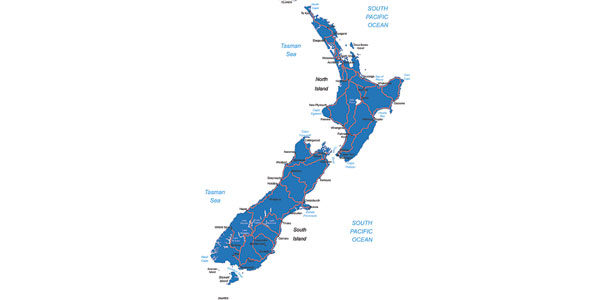The day I left Montana for New Zealand, it was cloudy and cold. We had just gone through a week of sub-zero temperatures, freezing fog and snow, and more of the same was headed our way. Farmers across the valley where I live were talking about the snow, the cold and how this winter was quite unusual.
Twenty-seven hours later, my plane landed in the middle of summer. Sunny skies and green grass welcomed me to my new home for the next six months.
After seeing nothing but white for several months, it was hard to believe that here the corn had yet to be cut for silage, and that farmers were baling their second or third cuttings of hay. As I traveled south, I passed numerous dairies and all of them had their cows outside grazing.
I am in New Zealand on a Fulbright research grant. I will be looking into how New Zealand dairy farmers make on-farm decisions in a free market. This is a comparison project to my master’s research on Montana’s quota system (see the “Pay to Play” article series from fall 2013 in Progressive Dairyman ) and how it affected a farmer’s business decisions.
My goal is to be able to provide some insight to both the U.S. and New Zealand about how national and local policies change the way farmers farm and possibly contribute to the changing structure of dairy farming.
New Zealand is well known in the dairy world as being the primary example of seasonal, pasture-based farming. Farmers breed their cows to freshen starting in late July, and most aim for a six-week calving period.
Dry-off happens in May and early June, so just about every farmer takes a break from milking for two months every year. Some farmers are starting to have two to three calvings per year, one indication of an industry moving toward year-round production.
The removal of subsidies and government control (a future article will focus more on this topic) in the mid-1980s changed the profitability across all farming sectors in New Zealand. Since then, dairies have been moving onto land traditionally worked by sheep or beef farmers and have started to increase in scale.
While this has helped fuel the growth of New Zealand’s economy, it has also raised some concerns regarding water quality, waste management and change in rural life.
Between 1992 and 2012, New Zealand dairy production skyrocketed. Production and processing jumped from 7.45 million liters to 18.8 million liters. Here, dairy production totals are measured in volume (3.7 liters to every gallon) while components are measured in kilograms (2.2 kg to every pound). Farmers are paid based on the kilograms of solids produced, not on total fluid production.
The number of cows has also increased from 2.6 million to 4.7 million, more than all of the people who live in New Zealand. Three-quarters of all the dairies are located on the North Island, primarily in a region known as the Waikato that is well known for its moderate climate and arable land. South Island herds tend to be larger and are growing in scale more quickly.
There are currently 11,891 farms, with nearly 50 percent of them having herds between 150 and 350 cows. Farms with herds of more than 500 cows make up 26 percent of the total, as opposed to more than 60 percent in the U.S.
There are five major dairy “breeds” tracked for statistical purposes: Holstein-Friesian, Jersey, Ayrshire, Holstein-Jersey cross and other. More than 40 percent of cows in New Zealand are Holstein-Jersey crosses. Purebred Holsteins come in second with 37 percent, and Jerseys are third with almost 12 percent.
The Holstein-Jersey cross is beginning to be recognized as its own breed for the purposes of insemination and record-keeping. The average calving interval for all breeds is 368 days and more than two-thirds of cows live beyond their sixth lactation.
Average per-cow production during the peak month of October is 22.96 liters per cow per day, or about 55 pounds. Cow production is often reported in kilograms per effective hectare, a measurement that indicates the productivity of the cow and the land. Because cows are grazing as their primary source of nutrition, it is an important measure to take to ensure that the land is being managed in the best possible way.
Farm management structures are also quite a bit different than in the U.S. Owner-operators, who may or may not employ outside labor, run about two-thirds of the dairy farms. Sharemilkers operate the remainder of farms. Sharemilking is a structure that is not well known or used in U.S. dairy.
There are different kinds of sharemilking that change the proportion of work and profit between the farm owners and the sharemilker. In some cases, the sharemilker owns the herd but not the land, while in other instances the sharemilker would not own anything and would be responsible for a certain portion of the work.
The most common arrangement is the 50-50. In this, the sharemilker owns the herd and any equipment needed to farm but not the milking parlor or other fixed structures. The sharemilker is responsible for milking, cow care and expenses, and taking care of the land. The owner maintains the permanent property. Income is then split 50-50 between the sharemilker and the farm owner.
Sharemilking is an effective way for young or new farmers to get into the dairy business. A farm worker can gain experience as an employee and then start to make the transition to farm ownership through sharemilking.
While there are expenses up front, such as the purchase of cows or equipment, farmers are transitioning into a management role without the additional debt load of buying a farm or putting in permanent facilities.
As a sharemilker becomes more experienced, he or she might work toward farm ownership and will have the cows, the equipment and the knowledge gained from operating a farm to take with them and use as equity when they decide to purchase.
The combination of low consumer population and high production means that 95 percent of all milk produced is exported to 151 countries. Major trade partners include China, the U.S., Japan and European Union countries.
The primary export products are generally those that reduce the weight of milk by extracting water such as cheese, infant formula and other bulk commodities. Fonterra is New Zealand’s largest dairy cooperative with 10,600 farmer members, and it processes 93 percent of milk produced in the country.
There are two other regional cooperatives that represent farmers from geographically distinct areas. There are also surprisingly few farms that add value to their own milk – the majority of those are organic farms.
New Zealand offers a different perspective on dairy farming, one that I am excited to explore over the next six months. I am still looking for dairy farmers to talk with, so if any readers know farmers here in New Zealand they’d like me to connect with please feel free to pass along my contact information.
In the next installment, I will be talking about what happened when the government chose to deregulate the industry and the current influence from the international market. PD
Laura Ginsburg is currently in New Zealand on a Fulbright research grant studying dairy policy and farmer decision-making. She wrote her master’s thesis on Montana’s supply management system. Contact her by email .







